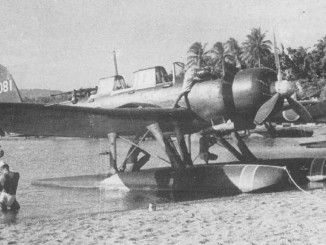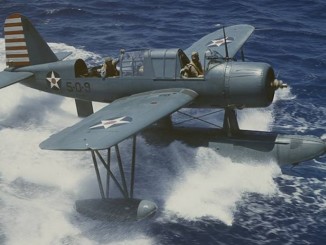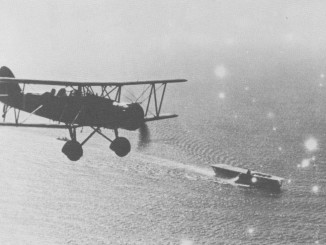
Requested as part of the same 12-Shi requirements, issued in 1937, that produced the A6M Zero, the G4M “Betty” and the E13A, the E14Y was a small seaplane designed to be carried aboard the Imperial Japanese Navy’s cruiser-submarines. The aircraft was designed to replace the older E9W that performed the same role. The design was produced by the Yokosuka Naval Air Technical Arsenal.
As an extremely small and light aircraft the Yokosuka E14Y did not require a powerful engine, and so was fitted with a Hitachi Tempu motor capable of delivering just 340hp. Critical to the aircraft’s role was the capability for the wings to fold so that it could be stored in the small watertight hangar just below the conning tower of each submarine.
E14Ys were carried aboard the Navy’s Junsen I and Type B1 submarines, which saw extensive action during the first two years of the Pacific War. The reconnaissance capabilities of the submarine/E14Y combination were demonstrated during successful missions over Pearl Harbor and several ports in Australia, New Zealand and New Caledonia.
Most famously the E14Y carried out the only bombing attack on the continental United States. In September 1942, an E14Y launched from the submarine I-25 dropped a pair of incendiary bombs on a forest in Oregon, hoping to start a wildfire that would rage out of control. Actual damage was light as the one fire started was controlled within a few hours.
In 1942 the E14Y was assigned the Allied Reporting Name “Glen”, based on intelligence reports of the type but before one had been observed directly.
Yokosuka E14Y Type 0 Specifications
| Yokosuka E14Y1 | |
| Role | Small reconnaissance seaplane |
| Crew | 2: Pilot, observer |
| Powerplant | 1x Hitachi Tempu 12 (340hp) |
| Speed | 104mph (cruise) 153mph (max) |
| Ceiling | 17,780ft |
| Range | 548 miles (internal) |
| Armament | 1x Type 97 7.7mm Machine Gun |
| Ordnance | 331lb bombs |
| Dimensions | 28ft 0in (length) 36ft 1in (wingspan) 12ft 6in (height) |
| Wing Area | 204 sq.ft. |
| Weight | 2,467lb (empty) 3,197lb (gross) 3,533lb (max) |
| Number produced | 126 |




Leave a Reply